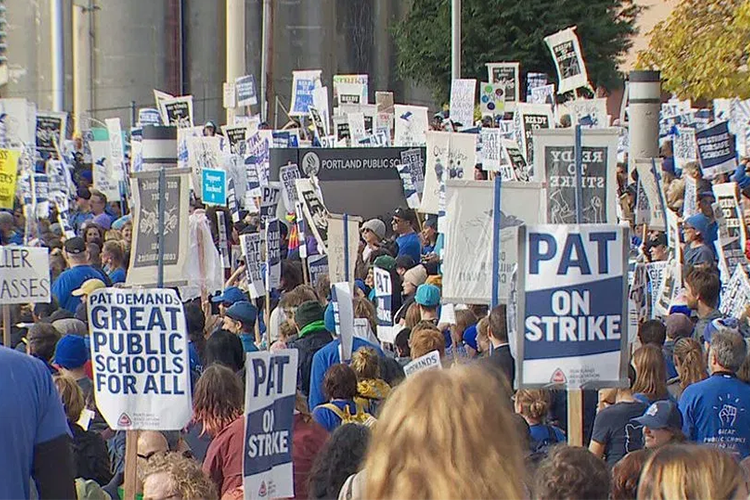
Supporters, members, and leaders of the Portland Association of Teachers protest down the streets of downtown Portland to demand better treatment for educators. photo courtesy of KATU
The Portland teachers’ strike ended on November 25th after educators reached a contract agreement with the district.
On November 1st, over 4,000 educators employed by Portland Public Schools (PPS) went on strike, temporarily closing all 81 of the district’s schools. While 49,000 students enjoyed their unexpected vacation, members of the Portland Association of Teachers (PAT) voiced their demands along the crowded streets of downtown Portland.
The PAT informed the district of the strike ten days in advance, permitting educators to legally protest. In the years leading up to the strike, countless teachers who are a part of PPS had expressed their complaints about sustainable workloads, fair salaries, and class sizes to district officials.
One of the foremost reasons for the strike was a lack of planning time for teachers across all grade levels. The contract between the union and district proceeding the strike permitted one class period of planning time per day for middle and high school teachers and allowed elementary school teachers no more than five and a half hours per week. Educators felt that this amount of time was insufficient to plan engaging and informative lessons for their students. This attitude, which is shared by many teachers, has been present for the past decade. A perfect example of this is Doug Saulter, a 26-year employee of PPS who decided to file a lawsuit against the school district back in 2016. Saulter complained that he was provided with just “seconds per student” to plan out his classes. In his complaint, Saulter also stated that the district was in violation of the Individuals with Disabilities Education Improvement Act of 2004, which requires children with disabilities to receive individualized instruction. Saulter alleged the district was in violation of this requirement due to a lack of planning time on all teachers’ behalf.
Planning time wasn’t the only disagreement prompting the strike. Another chief concern shared by PPS teachers was the overwhelmingly large class sizes. Tiffany Koyoma-Lane, a teacher in Portland, revealed to the National Education Association that she has had third-grade classes with up to 31 students. Koyama-Lane expressed the frustration of many teachers when saying that “the difference between [having] 21 and 31 [students per class]? Every student and family gets less of me.” In addition to their students’ needs, teachers in Portland were compelled to go on strike in hopes of receiving higher salaries. For years, teachers relied on the same salary to support themselves while the cost of living in the city continued rising.
After failing yet again to make a contract agreement with the district, members and supporters of the PAT marched from their headquarters across the Willamette River and into Tom McCall Waterfront Park. Some of the group chanted while others held signs with messages reading #PAT and #UnionStrong. With the mounting pressure from the protest and public, the district was eventually forced to meet the union’s demands. After 11 missed instructional days, teachers returned to their classrooms motivated by the change they inspired.
Among these changes was a 14% overall pay raise spread across three years, $20 million for classroom renovation, and a contract article committed to Special Education. However, students and educators will have to make up these 11 missed days of class time over winter break and into the new year. It is safe to say the sacrifice of these teachers and students throughout the strike was well worth it for the benefit of education in Portland.